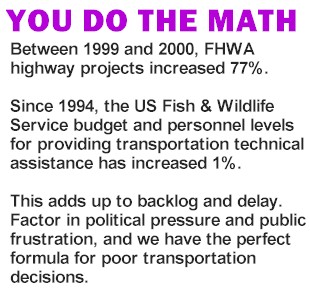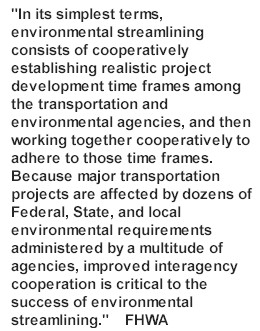| ENVIRONMENTAL
STREAMLINING
What is
Environmental Streamlining?
During the
legislative battle to reauthorize the Intermodal
 Surface Transportation Efficiency Act (ISTEA) in
1997 and 1998, the highway building industry and
interests pressured Congress to include language that
would "streamline" the environmental review procedures
as they are applied to transportation construction
projects. Many projects, they contend, are needlessly
delayed by strict environmental regulations, increasing
costs and denying American drivers the efficient
transportation system they deserve. "Over the years, the
well-intentioned NEPA process has become enmeshed in a
web of duplicative bureaucratic reviews." (Cooperative
Environmentalism, AHUA). Surface Transportation Efficiency Act (ISTEA) in
1997 and 1998, the highway building industry and
interests pressured Congress to include language that
would "streamline" the environmental review procedures
as they are applied to transportation construction
projects. Many projects, they contend, are needlessly
delayed by strict environmental regulations, increasing
costs and denying American drivers the efficient
transportation system they deserve. "Over the years, the
well-intentioned NEPA process has become enmeshed in a
web of duplicative bureaucratic reviews." (Cooperative
Environmentalism, AHUA).
Why do road
projects take so long?
Transportation
projects that receive Federal support must follow
environmental review procedures prescribed in the
national Environmental Policy Act (NEPA), which also
acts as an umbrella process for guiding compliance with
key elements of other Federal environmental laws, such
as the Endangered Species Act, Clean Water Act, and the
National Historic Preservation Act. NEPA establishes
three classes of environmental review actions for
transportation projects, based on the magnitude of their
anticipated environmental impacts:
- Environmental Impact Statement (EIS) - For
major projects with significant impacts
- Environmental Assessment (EA) - For projects
where impacts are not clearly established
- Categorical
Exclusion (CE) - For minor projects with little or no
significant impacts
It should be
noted that the vast majority of transportation projects
are not subject to environmental review and very few are
actually delayed. According to a 2000 AASHTO study, 91%
of all environmental documents produced by state DOTs
are Categorical Exclusions (CE). Less than 2% are EISs.
Contrary to the horror stories generated by highway
advocates, processing times for environmental review
average between 8 months and 3.5 years, depending on the
level of complexity associated with the analysis.
(Environmental Streamlining: A Report on the Delays
Associated with the Categorical Exclusion &
Environmental Assessment Processes, by TransTech
Management, Inc., October 2000).
Those that
require review may be delayed because they are sent to
already overburdened agencies which are  not funded, staffed or equipped to meet the
demand, in addition to management of our natural
resources, which is a formidable task by itself. Simply
put, TEA-21 significantly increased funding for new
roads and highways. It did not, however, increase
funding to the agencies charged with reviewing and
permitting all of these new projects. Until that
discrepancy is addressed, the backlog and delays will
continue. not funded, staffed or equipped to meet the
demand, in addition to management of our natural
resources, which is a formidable task by itself. Simply
put, TEA-21 significantly increased funding for new
roads and highways. It did not, however, increase
funding to the agencies charged with reviewing and
permitting all of these new projects. Until that
discrepancy is addressed, the backlog and delays will
continue.
Also, a great
deal of consideration goes into the process because
roads and highways are permanent changes to our
communities, imposing significant impacts on surrounding
areas, including economic, social, cultural, as well as
environmental. Many of the regulations that apply to
transportation projects are more to protect the human
environment than the natural environment, such as clean
drinking water and cleaner air.

WHAT DOES
TEA-21 SAY?
TEA-21, the
successor to ISTEA, contained the now-famous §1309,
which mandated the Secretary to "develop and implement a
coordinated environmental review process for highway
construction and mass transit projects..." The elements
of streamlining include:
- Agency
identification and participation: At the earliest
possible time, the DOT shall identify and notify all
state and federal agencies with jurisdiction or
review/permitting responsibilities for the
project.
- Concurrent
reviews: Presently, projects are reviewed by many
different agencies in sequence. Each agency must wait
for the one before it to review the project. Section
1309 suggests these reviews take place
simultaneously.
- Cooperatively determined time periods: All
agencies involved in the review will agree to delivery
dates, after considering respective resources and
other commitments.
- Assistance
to affected Federal agencies: State DOTs may provide
funds to the reviewing and permitting agencies to
assist them in meeting the cooperatively determined
time periods.
- Dispute
resolution: In the event that a review cannot be
completed within the cooperatively determined time
period, the DOT will provide notice and enter into
additional consultation before closing the
matter.
What is
Defenders’ position on Environmental
Streamlining?
There is no
question that America’s transportation infrastructure is
imperative to our mobility, productivity and success.
However, we cannot deny that it has also had significant
impacts on our environment. Four million miles of
roadways cover no less than 1% of our total land area,
approximately the size of the state of South Carolina.
Unfortunately, not all of those roads were planned
wisely, leaving a destructive – and permanent –
footprint on our landscapes and wildlife habitat. That
is why it is imperative that transportation decisions
are not made in haste, but after careful consideration
of not only the immediate need and purpose, but also the
long-term and cumulative effects. As well,
transportation decisions cannot be made in a vacuum, but
only after consultation with all stakeholders and
interested parties.
At the same
time, we believe legitimate concerns have been raised
about the need to find ways of reducing the length of
environmental reviews. From our perspective, we believe
that there are relatively few instances in which road
construction is in direct and irreconcilable conflict
with wildlife conservation. The goal of streamlining
should be to identify and meaningfully address those
conflicts at the beginning of the planning process, not
at the eleventh hour through litigation. The keys to
better up-front planning include earlier involvement by
stakeholders and natural resource agencies, more
resources to facilitate that involvement and a better
information base to facilitate meaningful input by
participants.
Defenders fully
supports the objectives of streamlining to the extent
that they lead to better, more wildlife-friendly
decision making. Specifically, we encourage:
- Early,
continued and substantive involvement. Many projects
are delayed because they are planned and designed
before regulatory agencies are ever consulted. If they
are involved from the beginning, they can steer DOTs
clear of problems early.
- Focus on
comprehensive planning. Regional and state
transportation plans that consider needs and
requirements of other sectors are less likely to be
delayed.
- An
integrated process, with public participation. We
believe that projects conceived and designed in the
mind and spirit of NEPA will meet the needs of the
American people, hence are less likely to be
delayed.
We would
strongly object to any measure that would weaken our
nation’s environmental protections – regulations that
receive widespread public support and that are largely
responsible for the quality of life we enjoy today.
While these regulations are strong in principle, in
practice, they rarely do more than temporarily delay
even the most harmful projects. Defenders contends that
these regulations better serve us all if they are
legitimately used to filter out and correct problems
rather than regarding them as little more than expensive
bureaucratic hurdles.
What is
Defenders doing?
We encourage
states to do transportation planning with conservation
in mind, and advocate greater public participation. We
also encourage state DOTs to involve permitting agencies
like the Fish and Wildlife Service in their plan and
design as early as possible to avoid 11th
hour surprises. Defenders intends to remain involved in
the streamlining discussion and advancing constructive,
proactive policies now and in TEA-3.
RESOURCES
LINKS
FHWA Environmental Streamlining
Page
Environmental Streamlining National
Memorandum of Understanding (MOU)
See
Federal Register, Vol. 65, No. 102, Thursday, May 25,
2000
Federal Highway Administration NPRM on NEPA
and Related Procedures for Transportation Decision
making, Protection of Public Parks, Wildlife and
Waterfowl Refuges, and Historic Sites
The Coalition to Save NEPA: Comments
on TEA-21's Treatment of Environmental
Review
|